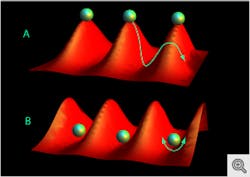Ann Arbor, MI--Building on earlier work, University of Michigan physicists have devised a way to optically trap giant Rydberg atoms with up to 90% efficiency, an achievement that could advance quantum computing and terahertz imaging, among other applications. "Our optical lattice is made from a pair of counter-propagating laser beams and forms a series of wells that can trap the atoms, similar to how an egg carton holds eggs," said Georg Raithel, a U-M physics professor and co-author of a paper on the work in Physical Review Letters. Other co-authors are physics doctoral student Sarah Anderson and recent doctoral graduate Kelly Younge.
The researchers developed a unique way to solve a problem that had been limiting trapping efficiency to single-digit percentages. For Rydberg atoms to be trapped, they first have to be cooled to slow them down. The laser cooling process that accomplishes that tended to leave the atoms at the peaks of what the researchers call the "lattice hills" and the atoms typically do not stay in those positions.
"To overcome this obstacle, we implemented a method to rapidly invert the lattice after the Rydberg atoms are created at the tops of the hills," Anderson said. "We apply the lattice inversion before the atoms have time to move away, and they therefore quickly find themselves in the bottoms of the lattice wells, where they are trapped."
Raithel says there is plenty of technological room left to reach 100% trapping efficiency, which is necessary for advanced applications. Rydberg atoms are candidates to implement gates in future quantum computers and could also be used in terahertz imaging and detection devices that could be used in airport scanners or surveillance equipment.
SOURCE: University of Michigan; http://ns.umich.edu/new/20144

